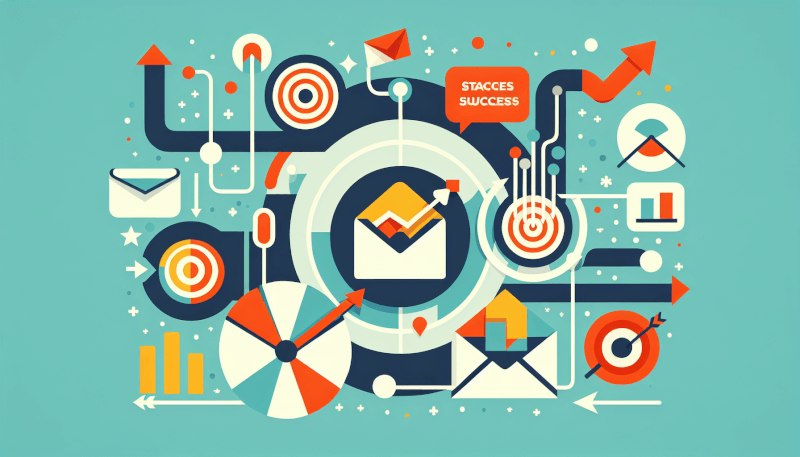Are you ready to take your email marketing to the next level? In this article, we will explore the power of segmentation and how it can skyrocket your success. By dividing your email list into specific groups based on demographics, interests, and behaviors, you can tailor your messages to resonate with your audience on a personal level. With the right segmentation strategies, you can increase open rates, click-through rates, and ultimately drive more conversions. So, grab a pen and paper, because we are about to unlock the secrets to email marketing success through effective segmentation.
Segmentation Strategies for Email Marketing Success
Email marketing segmentation is a crucial strategy for achieving success in your email marketing campaigns. By dividing your email list into specific segments based on various criteria, you can tailor your messages to resonate with each group, resulting in higher open rates, click-through rates, and ultimately, conversions. In this article, we will explore the importance of email marketing segmentation, its benefits, essential segmentation criteria, different types of segmentation, and techniques to optimize your segmentation efforts.
1. Understanding the Importance of Email Marketing Segmentation
Email marketing segmentation is the process of dividing your email list into distinct segments based on specific characteristics or behaviors. It allows you to better understand your subscribers and deliver highly relevant and targeted content to them. By segmenting your audience, you can avoid sending irrelevant emails that may end up in the spam folder or cause your subscribers to unsubscribe. Segmentation helps you build stronger relationships with your audience, increase engagement, and maximize the effectiveness of your email campaigns.
2. Benefits of Email Marketing Segmentation
Segmentation offers several benefits that can significantly impact the success of your email marketing efforts. Firstly, it improves your email deliverability. When you send highly targeted emails to specific segments, you reduce the chances of your messages being marked as spam. Additionally, segmentation allows you to send personalized content, which enhances the subscriber experience and increases the likelihood of conversion. Moreover, segmentation enables you to optimize your email marketing campaigns by analyzing specific segments’ performance and tailoring your strategies accordingly.

3. Essential Segmentation Criteria for Email Marketing
To effectively segment your email list, you need to consider various criteria that define your target audience. These criteria include demographics, geographic location, psychographics, behavior, and preferences. By combining multiple segmentation criteria, you can create precise and relevant segments that align with your marketing goals and target customers who are more likely to engage with your content.
4. Types of Email Marketing Segmentation
There are various types of segmentation strategies you can utilize in your email marketing campaigns. These include demographic segmentation, geographic segmentation, psychographic segmentation, behavioral segmentation, and preference segmentation. Each type has its advantages and can help you reach specific goals or target specific groups within your subscriber base.

5. Demographic Segmentation
Demographic segmentation divides your audience based on demographic information such as age, gender, income, education level, occupation, and marital status. This type of segmentation helps you understand the characteristics and needs of different demographic groups, allowing you to create personalized content that appeals to their unique interests and preferences.
6. Geographic Segmentation
Geographic segmentation categorizes your subscribers based on their geographical location, such as country, state, city, or zip code. This segmentation allows you to tailor your messages according to local preferences, weather conditions, cultural events, or language variations. By targeting specific regions, you can deliver more relevant content that resonates with your subscribers’ local context.

7. Psychographic Segmentation
Psychographic segmentation focuses on the psychological aspects of your audience, including their personality traits, values, attitudes, and lifestyle choices. This type of segmentation helps you understand the motivations and preferences of your subscribers on a deeper level. By delivering content that aligns with their psychographic characteristics, you can establish a stronger emotional connection and foster loyalty among your audience.
8. Behavioral Segmentation
Behavioral segmentation segments your subscribers based on their past behaviors and interactions with your emails and website. It takes into account factors such as purchase history, browsing behavior, email engagement, and response to specific offers or campaigns. By understanding the actions your subscribers have taken, you can send targeted emails that align with their interests and preferences, increasing the likelihood of conversion.

9. Preference Segmentation
Preference segmentation allows you to segment your audience based on their communication preferences, such as email frequency, content format (text, HTML), and topic interests. By respecting your subscribers’ preferences, you can deliver a better user experience and avoid overwhelming them with irrelevant or unwanted emails. This segmentation strategy helps you tailor your messaging approach to each subscriber, ultimately improving engagement and response rates.
10. How to Segment Your Email List
Segmenting your email list effectively requires collecting the right data and analyzing it to identify relevant segments. Start by identifying the segmentation criteria that align with your marketing goals and target audience. Then, collect the necessary data either through sign-up forms or by leveraging your existing customer data. Once you have gathered the data, use an email marketing platform or CRM system to create segments based on the identified criteria.

11. Collecting the Right Data
To collect the right data for segmentation, you need to be intentional about the information you gather from your subscribers. This can include basic demographic information, preferences, interests, and past purchase history. Utilize signup forms, preference centers, surveys, and data enrichment tools to gather relevant data and ensure its accuracy. Regularly update and maintain your data to ensure its effectiveness in creating targeted segments.
12. Analyzing and Interpreting Data
Once you have collected the necessary data, it’s important to analyze and interpret it to gain insights into your audience and identify meaningful segments. Utilize analytics tools and segmentation features within your email marketing platform to identify trends, patterns, and opportunities for targeting specific groups. By understanding your data, you can refine your segmentation strategy and create highly effective campaigns.
13. Implementing Email Marketing Segmentation
After analyzing the data and identifying relevant segments, it’s time to implement your segmentation strategy. Use your email marketing platform to create segments based on the defined criteria. Automate the process of assigning subscribers to segments to ensure accuracy and efficiency. By implementing segmentation, you can deliver targeted, personalized content to each segment, maximizing engagement and conversions.
14. Crafting Tailored Content
Segmentation goes beyond just dividing your audience into segments; it also involves crafting highly tailored content for each segment. Take the time to understand the unique interests, pain points, and motivations of each segment. Then, create content that addresses their specific needs and delivers value. By delivering personalized content, you establish credibility, trust, and relevance, driving higher engagement and conversion rates.
15. Personalization Techniques
Personalization is a key aspect of effective email marketing segmentation. Beyond addressing your subscribers by their names, consider utilizing dynamic content and personalization tokens within your emails to create a more individualized experience. Tailor your subject lines, greetings, and content based on each segment’s preferences and behaviors. Personalization helps create a stronger connection with your audience and increases the chances of them taking action on your emails.
16. Optimizing Email Deliverability
Email deliverability plays a vital role in the success of your email marketing campaigns. When implementing segmentation, it’s important to ensure that your emails reach the intended recipients’ inboxes. Maintain a clean and updated email list by regularly removing inactive or invalid email addresses. Follow email deliverability best practices, such as avoiding spam trigger words and optimizing your email design and coding. By prioritizing deliverability, you can maximize the impact of your segmented emails.
17. A/B Testing for Segmentation
A/B testing is an essential technique to optimize your segmentation efforts and improve email performance. Split your segments into smaller groups and test different approaches, such as subject lines, content variations, or call-to-action placement. Analyze the results and gather insights to refine your segmentation strategy and further personalize your emails. A/B testing helps you identify the most effective tactics and continuously improve the performance of your email campaigns.
18. Measuring the Success of Email Marketing Segmentation
Finally, it’s crucial to measure the success of your email marketing segmentation efforts to assess their effectiveness and make data-driven decisions. Monitor key metrics such as open rates, click-through rates, conversion rates, and revenue generated from each segment. Compare the performance of segmented emails to broader campaigns to determine the impact of segmentation on your overall email marketing success. Regularly analyze and adjust your segmentation strategy based on the insights gained from performance metrics.
In conclusion, email marketing segmentation is a powerful strategy that can significantly enhance the success of your email campaigns. By understanding the importance of segmentation, leveraging various segmentation criteria, and implementing personalized content, you can build stronger relationships with your audience and drive higher engagement and conversions. With effective data collection, analysis, and optimization techniques, you can continuously refine your segmentation strategy and achieve long-term email marketing success.


